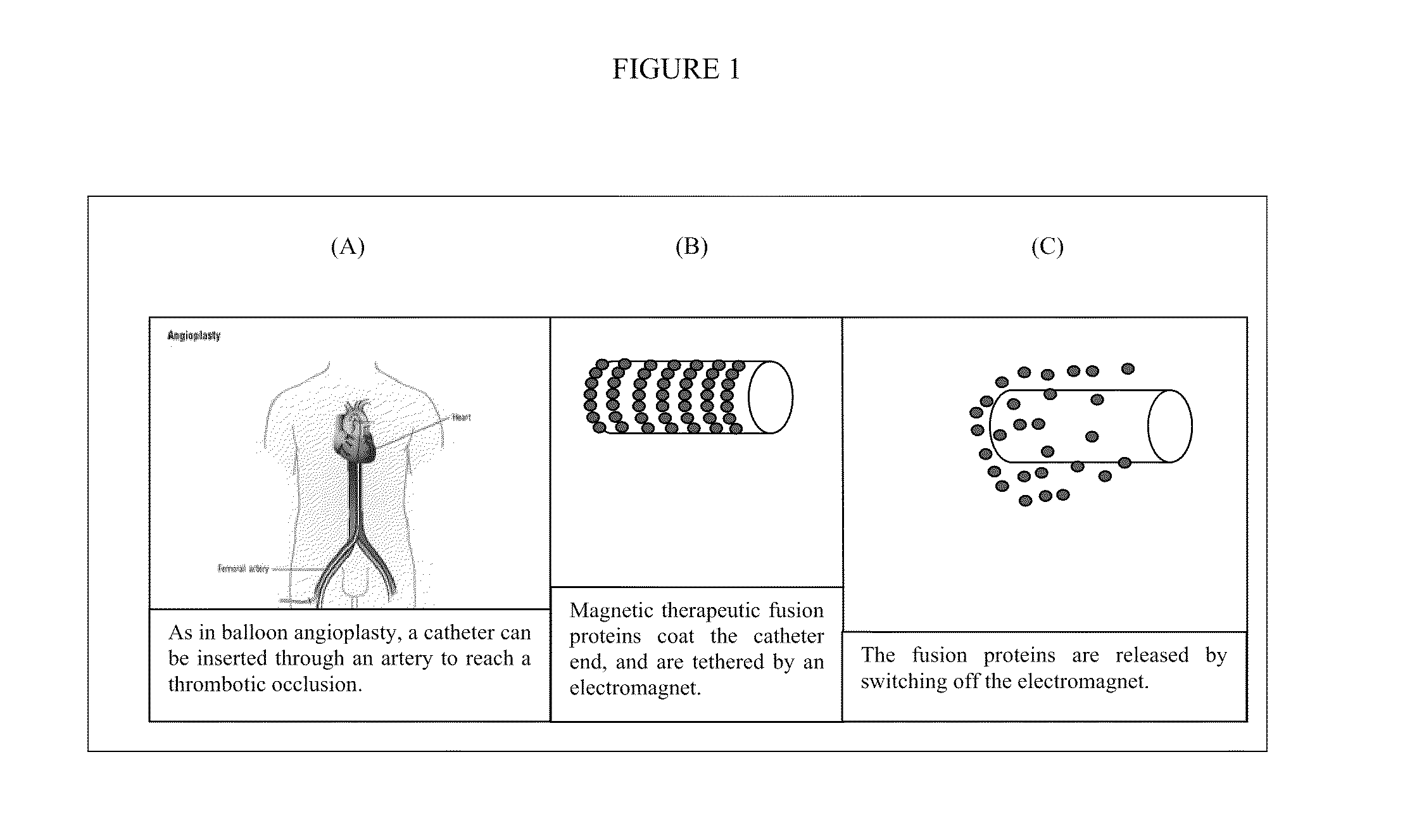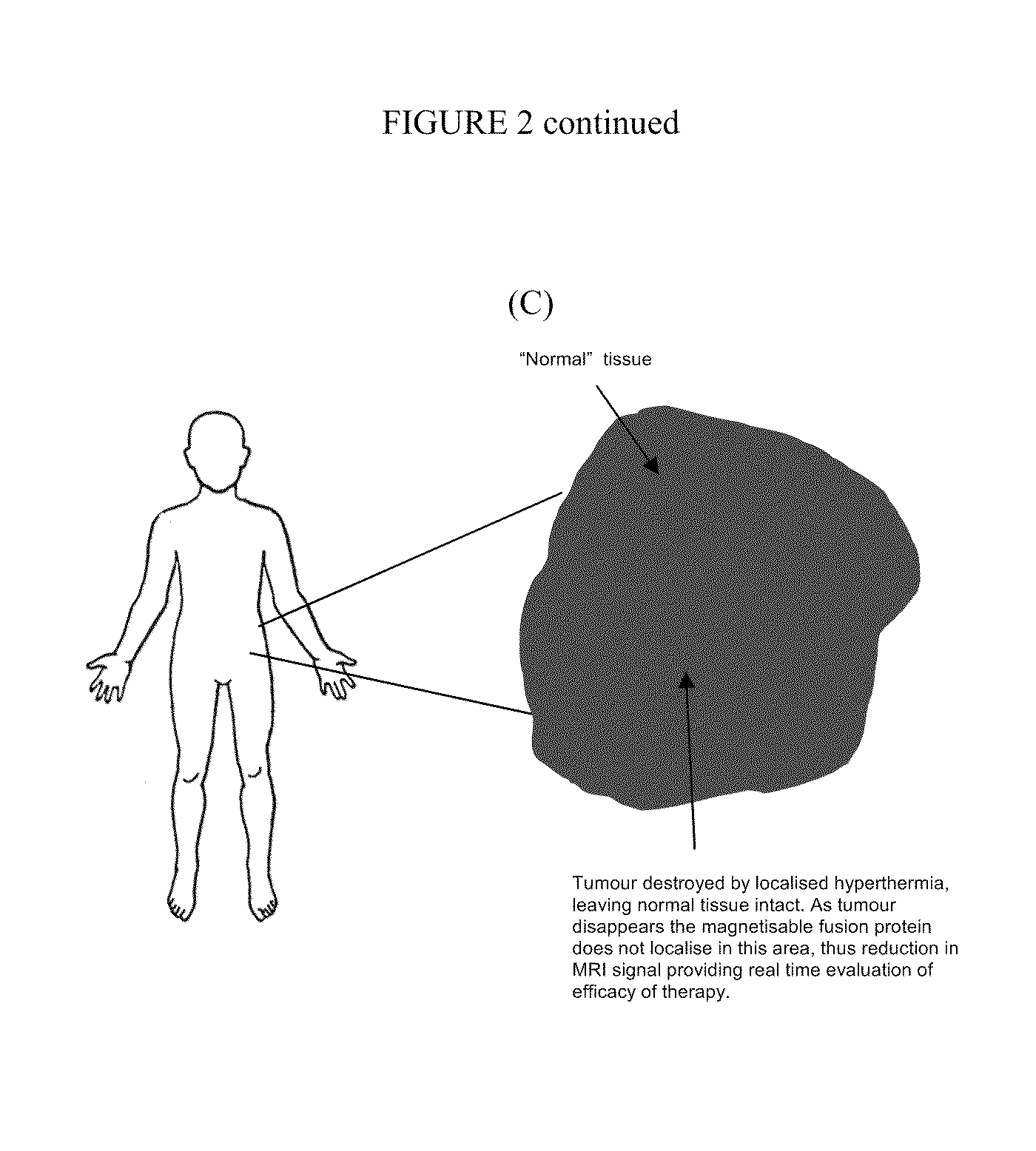Vector for use in medicine
a magnetic device and vector technology, applied in the field of magnetic devices for use in medicine, can solve the problems of polymorphisms in fc gamma receptors and may be less able to elicit an effective adcc respons
- Summary
- Abstract
- Description
- Claims
- Application Information
AI Technical Summary
Benefits of technology
Problems solved by technology
Method used
Image
Examples
example 1
Treatment of a Blood Clot
[0110]It is envisaged that the vector of the present invention will be used to treat a blood clot within a blood vessel in a patient. The vector will comprise a fusion protein comprising ferritin and an antithrombin III antibody fragment. The vector will further comprise Fe2O3 as the magnetic or magnetisable substance.
[0111]The vector will be attached to an electromagnet on the outside of one end of a catheter and the catheter will be inserted into the patient through the femoral artery. Once the catheter has been positioned as close to the site of the blood clot as is possible, the electromagnet will be switched off, releasing the vector. It is envisaged that the antithrombin III part of the fusion protein will bind to the enzymes of the coagulation system preventing further clotting.
[0112]The following experimental detail indicates how the fusion protein of a recognition moiety and a binding moiety can be made:
example 2
Design and Manufacture of Fusion Proteins
[0113]In order to exemplify the invention, fusion proteins were designed, using commercially available murine anti-fibronectin antibody. Fusion proteins consisting of anti-fibronectin scFv genetically linked by short flexible linkers to either MT2, or ferritin were produced. This Example details the construction of the fusion proteins, their characterisation and isolation.
[0114]The design of the anti-fibronectin ferritin or MT2 fusion proteins was based on cloning the VH and VL genes from a mouse anti-fibronectin antibody into a vector. Both genes were linked by short, flexible linkers composed of small non-charged amino acids. Immediately at the 3′ end of the VL gene, another short flexible linker led into either the ferritin genes or the MT2 gene. Both fusion proteins had a six-histidine region for purification on nickel columns. The fusion protein translation was terminated at a stop codon inserted at the 3′ end of the ferritin light gene ...
example 3
SPR Analysis
[0141]Anti-fibronectin ferritin and MT2 fusion protein inclusion body preparations were used in surface plasmon resonance (SPR) assays using a SensiQ instrument (ICX Nomadics).
[0142]For these experiments, a fibronectin peptide was coupled to the surface of a carboxyl chip. The fusion protein preps were then flowed over the chip and association (Ka) and dissociation kinetics (Ka) determined.
Fusion Protein Samples for Analysis Six samples of each fusion protein, with varying concentration from 0.0013-0.133 μM were produced in running buffer as set out in Table 2 and Table 3 below.
TABLE 2Metallothionein Fusion Protein 75 kDa:40 μl 100 μg / ml 75 kDa / 360 μl running buffer to give400 μl 10 μg / ml (0.133 μM) then:μl ofμM FPμg / ml FPμl of 10 μg / ml FPrunning buffer0.00130.120 (of 1 μg / ml)1800.00650.5101900.0131201800.053.75751250.17.5150500.133104000
TABLE 3Ferritin ED-B Fusion Protein 270 kDa:144 μl 100 μg / ml 270 kDa / 256 μl running buffer to give400 μl 36 μg / ml (0.133 μM) then:μl of...
PUM
| Property | Measurement | Unit |
|---|---|---|
| total volume | aaaaa | aaaaa |
| diameter | aaaaa | aaaaa |
| total volume | aaaaa | aaaaa |
Abstract
Description
Claims
Application Information
 Login to View More
Login to View More - R&D
- Intellectual Property
- Life Sciences
- Materials
- Tech Scout
- Unparalleled Data Quality
- Higher Quality Content
- 60% Fewer Hallucinations
Browse by: Latest US Patents, China's latest patents, Technical Efficacy Thesaurus, Application Domain, Technology Topic, Popular Technical Reports.
© 2025 PatSnap. All rights reserved.Legal|Privacy policy|Modern Slavery Act Transparency Statement|Sitemap|About US| Contact US: help@patsnap.com



